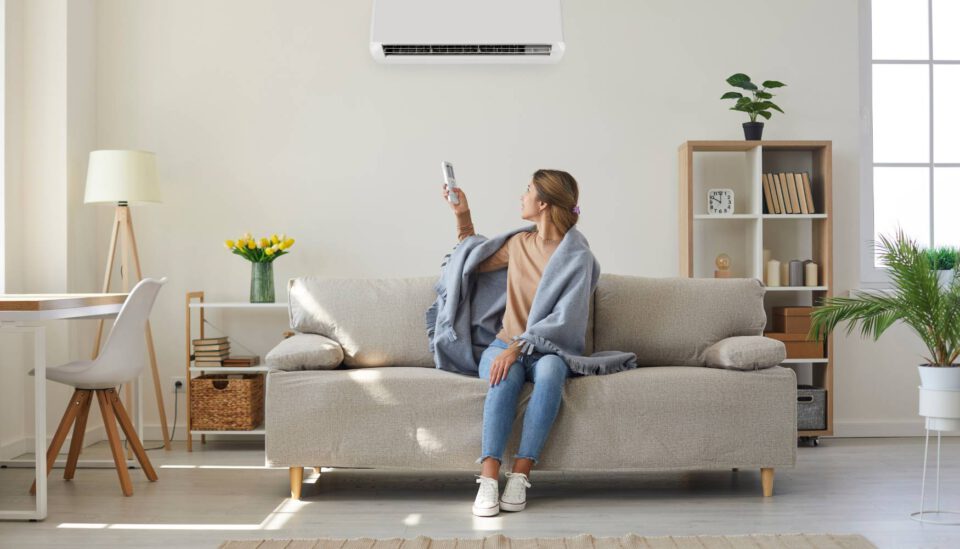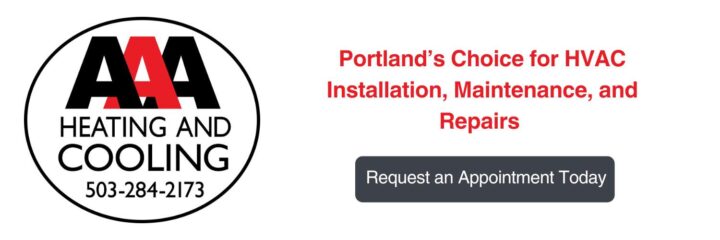
Maybe you’ve experienced it. You turn on your heater only to find the basement gets toasty-warm while the rest of the house stays freezing cold. What gives?
If your home suffers from poor HVAC ventilation, you’re throwing away your hard-earned cash on inefficient heating and cooling — and living in an uncomfortable home while you do it.
Luckily, there is a solution that lets you target your HVAC to certain areas of your home: zoning HVAC systems.
If you’re fed up with paying high utility bills for subpar HVAC, read on to learn more about how zoning HVAC systems may be part of the solution.

Table of Contents
- How Does an HVAC Zoning System Work?
- How Do I Know if I Have a Zoned HVAC System?
- Is Zoned HVAC Worth It?
- What Types of Homes Benefit from HVAC Zoning?
- Pros and Cons of Investing in an HVAC Zoning System
- How Much Does It Cost To Zone an HVAC System?
- Using Ductless Mini-Splits for HVAC Zoning
- AAA Heating & Cooling Can Help With the Installation and Maintenance of Your HVAC Zoning System
What Is a Zoning System for HVAC?
An HVAC zoning system divides your home into temperature zones, each of which is controlled by its own thermostat. This allows you to customize heating and cooling throughout the different areas of your home, improving comfort and potentially saving energy.
If you’re ready to improve the comfort of your home and tame your heating and cooling bills, the professionals at AAA Heating and Cooling can help. We’ve been providing HVAC services to our neighbors in Portland and the surrounding community since 1961, and we’d love to add you to our growing list of satisfied customers.
Request an appointment today.

How Does an HVAC Zoning System Work?
Most homes have ductwork with multiple ‘arms’ or runs, going from a single furnace and/or AC unit. Fans push hot or cold air up through the ductwork and into various parts of the home. An HVAC zoning system gives you power over what areas of your home receive HVAC by diverting hot or cold air through a series of air dampers in the ductwork.
For example, if you have a duct system that goes out from a main furnace or air conditioning unit, an HVAC zoning system can be installed that puts dampers in certain ducts. Via a programmable thermostat, you can monitor the dampers in those rooms, closing them when the rooms aren’t in use.
These remotely controlled ductwork dampers can be set to work in tandem, so only one area of the house or the other receives HVAC at certain times of the day. They can also be set to run on timers, so you’re only heating or cooling the rooms you’re using, saving you from having to heat or cool your entire home.
How Do I Know if I Have a Zoned HVAC System?
Your HVAC system may be zoned if you have:
- Multiple thermostats
- Dampers in your ductwork
- More than one heating system
Is Zoned HVAC Worth It?
Yes. While it’s true that any home upgrade costs money, it’s also true that HVAC zoning saves money over time by customizing your utility usage.
Since an HVAC zoning system allows you to customize the temperature in different parts of your home, such as cooling the living room during the day and your bedroom at night, almost all homes and businesses can benefit. However, it’s especially useful for:
- Large homes
- Multi-level homes
- Homes with sunrooms and high ceilings
- Homes with drafty windows
- Homes that have seasonal use areas like a gym or a loft
- A living space in the attic
- High ceilings
- A room over your garage
What Types of Homes Benefit from HVAC Zoning?
If you have one of these types of homes, you might benefit from the installation of an HVAC zoning system:
- Homes with lots of tall windows or sunrooms. We love windows but they can make a home hard to heat and cool. If you find you are losing excessive HVAC power in one or two areas of your home, HVAC zoning can help divert A/C and heating away from those areas.
- Homes with old furnaces and ductwork. An HVAC system is only as good as its ductwork and insulation. If you have a large, drafty house and an old furnace, you may benefit from an updated HVAC zoning system or a mini-split.
- Homes with lots of levels, such as basements or lofts. Why cool a room no one uses? If your home has multiple floors that are unoccupied during certain times of the year, such as a guest suite or a basement, you might be a good candidate for an HVAC zone system.
- Homes with areas of poor insulation. A lack of insulation leads to drafty, uncomfortable homes. By diverting the HVAC only to areas that are insulated, you can save money while living in a more comfortable environment.

Pros and Cons of Investing in an HVAC Zoning System
5 Pros of HVAC Zoning Systems
#1: Increased Energy Efficiency
HVAC zoning systems allow homeowners to choose what part of the home is heated or cooled and when. Using programmable thermostats, you can turn off the HVAC for unused parts of the home, or heat/cool the house for a certain amount of time.
With smart thermostats, you can even choose how to run the HVAC system remotely. All this helps conserve fuel and electricity, saving you money on utility bills.
#2: Improved Air Quality
Studies reveal that an HVAC zoning system improves air quality by limiting areas in your home where air is diverted. This means that any dust that might escape your HVAC filtration system won’t get circulated through the entire house.
In addition, zoning systems make it easy to locate and replace any clogged filters in the HVAC ductwork. With regular maintenance, an HVAC zoning system makes your air more comfortable — and safer.
#3: Temperature Control and Comfort
One of the main goals of an HVAC system is to make your home comfortable. By installing an HVAC zoning system in your home, you can customize the temperature of different ‘zones,’ keeping the HVAC where you want it.
This is all managed through programmable thermostats, which can be set to turn the HVAC zoning system off and on during certain times of the day.
#4: Reduced Wear and Tear
Since HVAC zoning reduces the workload needed in active zones, it minimizes the strain on your HVAC system. This can potentially extend the life of your system and lessen the need for repairs.
#5: Quick Installation
While the total time to install an HVAC zoning system depends on the scope of the installation, creating a zoned system can typically be accomplished in one to several days.

Cons of HVAC Zoning Systems
#1: Potential for Uneven Temperature Control
If the HVAC zoning system isn’t properly designed or maintained, it can lead to uneven temperatures throughout the zones. Avoid this problem by calling the professionals at AAA Heating and Cooling to get the job done right.
#2: HVAC Zoning System Maintenance and Updates
In addition to installation costs, HVAC zoning systems require regular maintenance to ensure proper functioning. This maintenance may include:
- Updating smart programmable thermostats
- Replacing clogged filters
- Cleaning the vents
- Repairing and updating ductwork
When completed regularly, maintenance is cost-efficient. But if maintenance lapses and your HVAC zoning system breaks, it may be even more expensive to replace.
#3: Ductwork May Be Required
Ductwork is complicated and depends heavily on how your home was built. If it’s relatively modern, your home may already be set up for zoning with dedicated ductwork for different areas of your home.
However, if your home is older, it may require work to adapt to an HVAC zoning system.
#4: Cost of Installation
As with any home project, the cost of a new HVAC zoning system will depend largely on your home and how much ductwork is already in place.
If you only want one or two HVAC zones and your home or business already has the ductwork required, it will likely be less expensive than if there is inadequate ductwork.
It is important to note that the cost of an HVAC zoning system installation is usually offset by savings in utility bills over time.
How Much Does It Cost To Zone an HVAC System?
The short answer is, it depends.
Because HVAC zoning systems are customized, cost is based on how many HVAC zones are installed and whether the required ductwork is already in place.
The best way to find out how much an HVAC zoning system will cost is by reaching out to trusted HVAC professionals, like AAA Heating and Cooling.
Whether you’re in the market for a residential or commercial HVAC zoning system, we can meet your need for HVAC repair, maintenance, and installation at reasonable prices.

Using Ductless Mini-Splits for HVAC Zoning
If you’re intimidated by the cost of installing a duct-based HVAC zoning system, consider installing a mini-split. Mini-splits disperse HVAC directly, without ductwork, and are controlled by programmable smart thermostats.
With this method of HVAC zoning, a heater and air conditioner are installed directly into the areas you want to heat or cool. The mini-split can be mounted onto the:
- Wall
- Ceiling (this is called a ‘cassette’ mini-split)
- Baseboards
This is a great HVAC zoning option for homeowners who don’t have the ductwork needed for other HVAC zoning methods.
Ready to learn more about this modern and cost-effective HVAC zoning solution?
Check out AAA Heating and Cooling. Our experts are happy to help you decide which route is best for your home. Contact us today to learn more or schedule a quote.
AAA Heating & Cooling Can Help With the Installation and Maintenance of Your HVAC Zoning System
Home maintenance and improvement can be beyond overwhelming.
With all the ever-increasing costs of home ownership, you want to feel confident you’re getting the best possible deal from contractors you can trust.
Enter AAA Heating & Cooling. Our Oregon-based, family-owned business has been providing service to Portland and the surrounding neighborhoods since 1961.
Our experienced team offers the highest quality residential and commercial:
- HVAC services
- Repairs
- Installations
- Maintenance
- Diagnostics
If you’re considering HVAC control systems in Portland, reach out to AAA Heating and Cooling for a free estimate.
